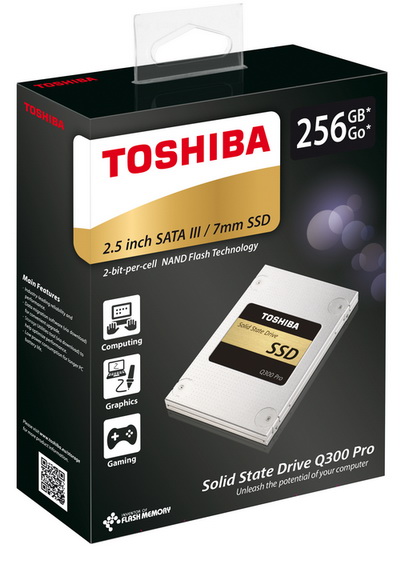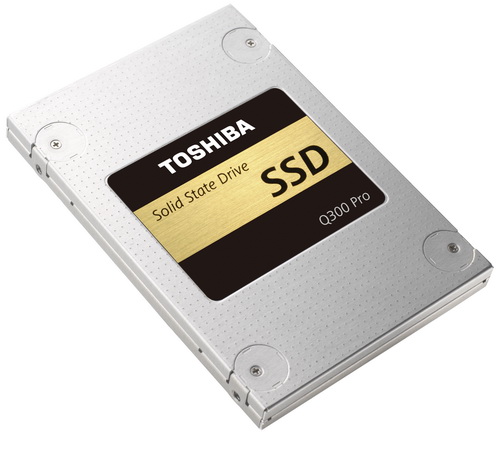INTRODUCTION
With most mainboards featuring at least one M.2 port and most enthusiasts turning towards PCIex models noone really knows just for how long manufacturers will keep focusing their efforts in the production of new SATA based solid state drives. On the other hand SATA models will probably take a lot longer to disappear from the market entirely (if ever) compared to IDE ones so i really doubt casual consumers have anything to worry about. Regardless today manufacturers release many SATA SSDs per year with specifications and capacities that can cover from casual users and gamers up to the most demanding enthusiasts and professionals. Toshiba has been in the SSD market for many years now (they were the ones to invent flash memory) but since their acquisition of OCZ a couple of years back they've been stepping up their game and today with us we have one of their latest SSD models the Q300 Pro 256GB.
Toshiba Corporation, a Fortune Global 500 company, channels world-class capabilities in advanced electronic and electrical product and systems into three focus business fields: Energy that sustains everyday life, that is cleaner and safer; Infrastructure that sustains quality of life; and Storage that sustains the advanced information society. Guided by the principles of The Basic Commitment of the Toshiba Group, “Committed to People, Committed to the Future”, Toshiba promotes global operations and is contributing to the realization of a world where generations to come can live better lives. Founded in Tokyo in 1875, today’s Toshiba is at the heart of a global network of 550 consolidated companies employing 188,000 people worldwide, with annual sales surpassing 5.7 trillion yen (US$50 billion). (As of March 31, 2016.) To find out more about Toshiba, visit www.toshiba.co.jp/index.htm.
Toshiba announced and released the TLC-based (3-bit-per-cell flash) Q300 SSD line and the MLC-based (2-bit-per-cell flash) Q300 Pro SSD line back in late 2015 which are currently available in 120/240/480/960GB (Q300 line) and in 128/256/512/1024GB (Q300 Pro line) capacities. Toshiba has once again designed a DRAM-less drive so aside using their very own NAND flash controller (TC358790 - not much is known about it) and A15 (advanced 15nm) Toggle MLC NAND flash for the Q300 Pro line there's nothing else under the hood (cache is held in flash). The drive also supports TRIM, garbage collection, NCQ (native command queuing) and QSBC enhanced error correction (quadruple swing-by code), TCG/OPAL 2.0, advanced power management and features an MTTF (mean time to failures) of 1.5 million hours, 160TB TBW endurance and Toshibas Adaptive Size SLC Write cache technology which basically treats a portion of the NAND as SLC while in use (pseudo SLC) to significantly improve write performance. Toshiba also covers the Q300 Pro line of SSDs with a 5 year warranty (3 years for the Q300 line).
SPECIFICATIONS AND FEATURES

PACKAGING AND CONTENTS
Toshiba ships the Q Series Pro inside a nice box that features a large product image at the front, the capacity of the drive and the type of NAND used (MLC).

At the rear Toshiba has placed the features of the product in 9 languages right above the contents of the bundle.
Along with the Q300 Pro 256GB SSD you'll also get 7mm to 9.5mm adapter (for use with laptops), registration paper, warranty papers and a quick start guide.
THE Q300 PRO 256GB
Just like most SSDs in the market today the Q300 Pro is 2.5" and 7mm thick.
A large sticker at the rear contains information about the drive such as the model name, serial and part numbers, barcodes, factory rollout date, installed firmware version, electrical requirements, capacity and several certification logos.
Once again at the rear we see the usual SATA power and data connectors right next to 4 pins probably used for firmware updating.
Opening the enclosure is not hard and as you can see the 256GB model has everything placed on one side of the PCB.
Toshiba has placed pads on the components to transfer heat onto the aluminum housing.
Removing them reveals the A15 NAND flash modules (total of 4 each 64GB in size) and the TC358790 controller.
TOSHIBA STORAGE UTILITIES






Much like oquite a few SSDs in the market for the Q300/Q300 Pro lines Toshiba has their very own configuration software available online. It may not be that different compared for example to Samsung’s Magician (it allows you to check the drive for errors, optimize the SSD via TRIM, enable/disable system tweaks for SSDs and set overprovisioning) but it still beats not having one at all (plus it’s very easy to use).
TEST BED


TESTING METHODOLOGY
After roughly 8 years of testing sold state drives i have concluded that it's almost impossible for any single benchmark suite to accurately measure their performance and that's why in certain benchmark suites we see amazing read/write performance numbers with some drives while in others things are quite different. The reason behind this is that some benchmarking suites are configured to read and write random chunks of data while others read and write constant (sequential) ones. So that's why i always use a very wide selection of benchmarking suites including AIDA64, HD Tach RW, HD Tune Pro, Crystal Disk Mark, Sisoftware Sandra Pro, AS SSD, IOmeter and ATTO. To get the most accurate results each test gets repeated a total of 6 times with the average performance numbers recorded into our charts. Also as of February 25th 2015 our results will also include the Storage Networking Industry Association’s (SNIA) IOMeter tests. These tests include a 12 Hour write test used to “simulate” performance degradation over time and a mixed workload test which basically shows what you can expect when using an SSD continuously for roughly two hours. Unfortunately due to the time required for these tests we repeat them a total of 3 times and not 6 as the above.
Many people have made inquiries about our charts in the past so once again please do keep in mind that the Charts have the average performance numbers of each drive recorded and not the peak (highest) ones. Also although every single one of these programs can help potential buyers choose the right drive for their needs you should also remember that from any kind of benchmark up to real world usage the gap is not small (and usually most differences will go unnoticed by most people). All tests were performed in a fresh Windows 7 Ultimate x64 installation with every update installed up to July 1st 2016.
TEST RESULTS - AIDA64 / ATTO


TEST RESULTS - HD TACH RW / HD TUNE PRO


TEST RESULTS - SISOFTWARE SANDRA PRO / CRYSTAL DISK MARK X64


TEST RESULTS – AS SSD / IOMETER


TEST RESULTS – IOMETER SNIA
CONCLUSION
Releasing an SSD model without a DRAM module is not a first time for Toshiba and although because of that their SSDs do take a performance hit thanks to the Adaptive SLC write cache technology it’s almost impossible to spot. On the other hand however although their SLC write cache technology works as advertised the MLC portion used with it is obviously not “large” enough and that’s very easy to spot in some of our tests. That being said both read and write performance levels are very good and in most of our tests surpass those of similar models like the 535 Series by Intel (in IOMeter however the 535 takes the lead). Thanks to the Storage Utilities software by Toshiba things get even more interesting but without checking out its price we can’t really make up our minds.
Price seems to be the quite balanced too (especially since you’re also getting NTI's Echo 3 software for drive cloning) since the Toshiba Q300 Pro 256GB currently retails for USD99.99 inside the USA (Amazon.com) and for 108Euros inside the EU (Amazon.co.uk). True you can find other 240/250/256GB models like the 850 EVO by Samsung for slightly less but you will need to spend slightly more (roughly 5-10% for let’s say the Extreme Pro by SanDisk) to get one of the faster models in the market. At the end of the day we do feel that Toshiba has the resources and knowledge to release something faster and better than the Q300 Pro but still thanks to its performance, features, bundle and 5 warranty this is a solid solution for consumers and gamers and that’s why it gets our Golden Award.

PROS
- Build Quality (Toshiba 15nm Toggle-Mode NAND Flash/Toshiba Controller)
- Very Good Performance
- Retail Bundle (7mm To 9.5mm Bracket / NTI Echo 3 Cloning Software
- 5 Years Warranty / 1.5 Million Hours MTTF
- Toshiba Storage Utilities
- Price (For Some)
CONS
- IOmeter SNIA Performance

 O-Sense
O-Sense























.png)

